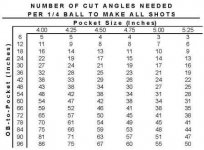Patrick,
Nothing silly or combative about my comments. Your post I was replying to attempted to define difficult cut shots due to the angle to the pocket as easy. When you wished to redefine "easy" was where the difficulty in communication arose. If you refuse to accept typical definitions of "easy" and "difficult" then I have no choice but to ask you to research these terms. I had already spelled out what I meant. Your deliberate obtrusiveness interferes with your ability to process information. Others had no difficulty understanding my terms.
Of course calling my comments "silly" and "combative" is indeed silly and combative.
Most shots in a real game of pool go using almost any accepted system simply because if you shot the last shot before it and played shape properly the shot is usually "easy" by anyone's definition of easy except possibly yours.
Here are the definitions of "easy" and "hard" that I and most of the world use when the words are used to define degree of difficulty. I hope this is of aid in ending any confusion.
Hu
(included text)
eas?y Audio Help /ˈizi/ Pronunciation Key - Show Spelled Pronunciation[ee-zee] Pronunciation Key - Show IPA Pronunciation adjective, eas?i?er, eas?i?est, adverb, noun
?adjective 1. not hard or difficult; requiring no great labor or effort: a book that is easy to read; an easy victory.
hard Audio Help /hɑrd/ Pronunciation Key - Show Spelled Pronunciation[hahrd] Pronunciation Key - Show IPA Pronunciation adjective, -er, -est, adverb, -er, -est, noun
?adjective 1. not soft; solid and firm to the touch; unyielding to pressure and impenetrable or almost impenetrable.
2. firmly formed; tight: a hard knot.
3. difficult to do or accomplish; fatiguing; troublesome: a hard task.
4. difficult or troublesome with respect to an action, situation, person, etc.: hard to please; a hard time.
5. difficult to deal with, manage, control, overcome, or understand: a hard problem.
6. involving a great deal of effort, energy, or persistence: hard labor; hard study.
(pay particular attention to definitions 3 through 6, 3 and 5 are most pertinent. hu)
Patrick Johnson said:
Silly combative comments like this won't get us anywhere, Hu.
So you define "easy" to mean those shots that go without compensation? OK, that's not the common definition, but I'll go with it. Using that definition, with these systems most shots are "hard". Of course, it would be better for communication to avoid words with special definitions. Here's my statement without reference to words like "easy" or "hard":
Even taking into account the "margin of error" for pockets being larger than balls, most shots cannot be pocketed using "approximating" systems like Fractional Aiming, Center-to-Edge, etc. without adjusting or compensating by "feel" from the strict formula aim prescribed by the system. This is true even if you limit the shots in question to those with less than, say, 45 degrees of cut angle.
pj
chgo

